Sintering is a manufacturing process in which a powder is heated without melting the grains is transformed into a solid mass. This process allows an easier production of finite objects made of materials with high melting point, such as metals, ceramics or composite materials.
The Spark Plasma Sintering (SPS) is a technique for powder sintering. In brief, the SPS machine is composed by a die-punch assembly made of graphite where the powders are placed (fig. 1 a), a hydraulic jack and a control system. An electric current flux flows through the assembly and heats the sample by Joule effect (fig. 1 b), meanwhile the jack applies a vertical load to increase the product final density. The SPS technique has several advantages: (i) it is a very fast process that can be used for industrial applications, (ii) it works with lower temperatures, meaning less required energy, (iii) it allows the control of the final product density, enhancing its material properties.
An irregular shaped specimen is manufactured using two different powders: the material that constitute the object – stabilized by a negligible amount of binder – and an inert powder, that fills the voids between the specimen and the SPS machine.
Our CompMech group member Michele Torre, under the supervision of Prof. Alessandro Reali and Prof. Simone Morganti, in collaboration with LAMSC (Department of Chemistry, University of Pavia), is working on the shape identification of pre-sintered powders.
The powder densification process, due to thermal effects and compressive load, changes the final shape of the object (fig. 1 c and d). In this context, numerical simulations are useful tools for the identification of the pre-sintering shape of the specimen, for the given post-sintering one.
December 16th, 2020


